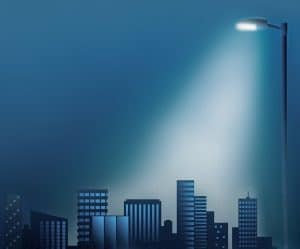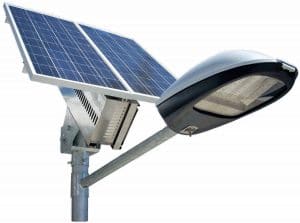 The Street Lighting National Programme (SNLP) was launched by Prime Minister Modi in January 2015, to convert all street lighting to LEDs. The plan was to cover 100 cities by March 2016, and the remaining by March 2019, targeting the replacement of 770 million bulbs and 35 million streetlights. However, it seems streetlights will be upgraded to LEDs ahead of schedule.
The Street Lighting National Programme (SNLP) was launched by Prime Minister Modi in January 2015, to convert all street lighting to LEDs. The plan was to cover 100 cities by March 2016, and the remaining by March 2019, targeting the replacement of 770 million bulbs and 35 million streetlights. However, it seems streetlights will be upgraded to LEDs ahead of schedule.
By Baishakhi Dutta
As LED lighting continues to become more affordable, cities around the country have begun investigating the benefits of switching from traditional street lighting to the far more energy-efficient LED lighting technology. Apart from the energy savings, the longer life span of the bulbs and the improved light quality that LEDs offer, the other huge benefit of this technology is how it can be remotely controlled. By adopting intelligent networking solutions, cities can revolutionise their street lighting infrastructure in order to deliver an attractive, sustainable, and safer living space.
Advantages of LED streetlights
- Have a very long life
- Reduced maintenance costs
- Do not contain toxic chemicals (like mercury)
- No warm-up needed (instantly reach optimum brightness levels)
- Ultraviolet light is not produced (which is what attracts insects)
- Useful for directing light on specific areas, since they produce directional light rather than a diffused glow
- Can be dimmed (unlike CFLs), allowing for flexibility in controlling light levels
- High colour index, providing bright, true colours at night
- No glare, which reduces visual fatigue for both drivers and pedestrians
Design and style of LED streetlights
Heat-sinks for LED streetlights are similar in design to those used to cool other electronics such as computers. They tend to have as many grooves as possible to facilitate the flow of hot air away from the LEDs. The area of heat exchange directly affects the life span of the LED streetlight.
The life span of an LED streetlight is determined by its light output compared to its original design specifications. Once its brightness decreases by 30 per cent, an LED streetlight is considered to be at the end of its life.
Most LED streetlights have a lens on the LED panel, which is designed to cast its light in a rectangular pattern. This is an advantage compared to traditional streetlights, which typically have a reflector on the back of a high-pressure sodium lamp. In the latter case, much of the luminance of the light is lost, resulting in light pollution in the surrounding environment. Such streetlights can also cause a glare for drivers and pedestrians.
Solar street lighting
 In solar LED lighting, solar energy is used to charge a self-contained battery during day time and, at night, the battery powers the streetlights. Solar LED street lighting is an especially cost-effective solution for parking lots, parks, residential streets, airports and other applications where providing electricity is expensive or problematic. The additional benefit of these types of LEDs is ease of installation —since the lamps rely on solar power, there is no need to dig trenches to lay underground cables. These lights are also immune to power outages, which is another advantage.
In solar LED lighting, solar energy is used to charge a self-contained battery during day time and, at night, the battery powers the streetlights. Solar LED street lighting is an especially cost-effective solution for parking lots, parks, residential streets, airports and other applications where providing electricity is expensive or problematic. The additional benefit of these types of LEDs is ease of installation —since the lamps rely on solar power, there is no need to dig trenches to lay underground cables. These lights are also immune to power outages, which is another advantage.
Energy efficiency
The primary appeal of LED streetlights is their energy efficiency compared to conventional street lighting technologies such as high pressure sodium (HPS) and metal halide (MH). Ongoing research continues to improve the efficiency of newer models of LED streetlights.
A streetlight based on a 901-milliwatt LED can produce the same amount of (or higher) luminance as a traditional light, but consumes only half the power. Typically, an LED light does not fail, but instead decreases in output till it needs to be replaced.
As LED lighting fixtures normally produce less illumination, it is crucial to have a well distributed illumination pattern in order to achieve the same luminance levels as higher lumen conventional fixtures. So, a well-designed LED streetlight will have LEDs in the same fixture pointing towards different target points.
How to make a purchase
The purchase decision for LED streetlights needs to be done carefully, as the investments are high.
- Product quality: This refers to the streetlight’s life, efficiency, ability to withstand extreme environments/weather conditions and the maintenance needed, including after-sales service.
- Watts: The lower the watts, the less electricity the LED will consume.
- Lumens: Lumens are a measure of brightness or light output. The more the lumens per watt, the better the light. Lumens per watt vary with the beam angle.
- Beam angle: Typically, an LED light has a beam angle of 120 degrees but downlights have different beam angles, so it’s important to choose the right beam angle for your specific needs.
- Colour: LEDs are available in various colours—from white (day light) to yellow (warm light). Choose the colour based on your preference or requirements.
Latest trends
Different designs incorporate various types of LEDs into a light fixture. The current trend is to use high-power 1-watt LEDs. However, some companies use low-power LEDs in their products, packing several of these together to perform the same task as a single high-power LED. The shape of the LED streetlight depends on several factors, including LED configuration, the heat-sink used with the LEDs and aesthetic design preferences.
Certifications
- IES LM-79: This certifies the electrical and photometric measurements of solid state lighting products
- IES LM-80: This is a method for measuring lumen maintenance for LED light sources
- IS 10322: This is for general safety, insulation resistance, high voltage, overvoltage protection, environmental tests, endurance tests, etc
- IS 1944: This is for general illumination requirements of the road
- IS 16104: This certifies the performance of the electronic control gear for LED modules
Case studies
Rajasthan
Rajasthan has become the first state to adopt the Centre’s Street Lighting National Programme (SLNP) in all its urban local bodies (ULB). Almost 500,000 conventional streetlights have been replaced with LED streetlights across the state.
Mangaluru (Karnataka)
Stating that installing LED streetlights will reduce the electricity bill of the Mangaluru City Corporation, the minister for urban development and Haj, R. Roshan Baig, has instructed the civic body to install LEDs all over the city.
Hyderabad (Telangana)
The Greater Hyderabad Municipal Corporation (GHMC) has replaced all high pressure sodium vapour (HPSV) streetlights with light-emitting diodes (LEDs) ahead of Ugadi. This initiative will save GHMC about Rs 1 billion annually.
East Godavari (AP)
The New and Renewable Energy Development Corporation of Andhra Pradesh (NREDCAP), the nodal agency of MNRE, has decided to provide streetlights of 28W to all panchayats in Andhra Pradesh with a 100 per cent subsidy.
Tamil Nadu
Under the guidance of the late chief minister, J. Jayalalithaa, announcements were made to install LED bulbs in all municipal corporations and municipalities in Tamil Nadu.
Thiruvananthapuram (Kerala)
Thiruvananthapuram is close to signing an agreement with SIDCO to replace 84,000 streetlights with LEDs after a postponement of nearly two years
Operation and maintenance
Energy consumption for street lighting can be reduced by incorporating good maintenance practices such as:
- Replacing defective lamps, accessories and wires
- Early rectification of cable faults
- Making sure that cables are joined properly
- Regular maintenance of service cabinets/fuse boxes to avoid loose connections
- Regular cleaning of the luminaire cover to keep it free of dust/dirt and increase light output
A substantial amount of energy savings can also be achieved by installing mechanical/electronic timers and/or daylight sensors to turn streetlights on and off, based on ambient light conditions.
Health concerns about LED streetlights
- Exposure to the light of white LED bulbs suppresses melatonin production by up to five times more than exposure to the light of high pressure sodium bulbs. The fact that white light, emitted at wavelengths of 400-500 nanometers suppresses the production of melatonin by the pineal gland is known. The effect is a disruption of a person’s biological clock, resulting in poor sleep patterns.
- Artificial night-time lighting has various effects on humans (not to mention wildlife), and exposure to optical radiation affects human physiology and behaviour, both directly and indirectly.
- There are risks that arise from glare. A luminance level higher than 10,000 cd/m² causes visual discomfort, whatever the position of the lighting unit in the field of vision may be.




























